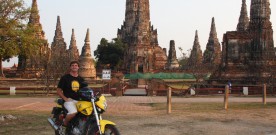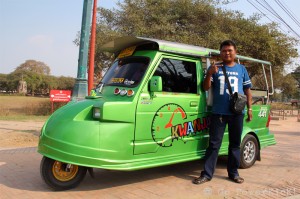For 417 years the ancient island-city of Ayutthaya was the capital of the most wealthy, culturally diverse and militarily dominant Kingdom in Siam, the Kingdom of Ayutthaya. With its three palaces and over 400 temples, accounts from foreign traders who visited Ayutthaya labeled it as one of the grandest cities in Asia, putting it on par with Paris because of its size and striking beauty.
The history of Ayutthaya was forever changed in 1767 A.D. when the invading Burmese army ransacked its temples and beheaded nearly all its Buddha statues during their conquest to topple the city and expand their empire. Today, the ruins of this once shining city on the water are easily accessible from Bangkok and make for a great day trip or, if you have the time, a nice weekend getaway. Here are the must see sights in Ayutthaya that’ll give a good lesson into Thai history and culture as well as help create mental images of just what this city might have looked like in its prime.
Wat Chaiwatthanaram
Located across the river from the southwest side of the island, this temple is one of the larger complexes in Ayutthaya. Built in 1630 A.D. the 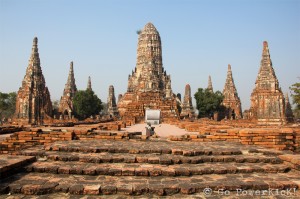 temple has an architectural style similar to that of Angkor Wat in Cambodia. In the centre of the complex is a 35 meter high prang (tower), which is surrounded by eight smaller chedis that form an inner courtyard. Stairs lead up to small alcoves at the top of each of the four sides of the prang where Buddha images used to sit, however, today the Buddha statues are gone and candles and incense have taken their places. The inner courtyard is lined with 120 headless and limbless Buddha statues, a lasting remnant of the Burmese invasion. Admission to the temple is 50 Baht ($1.54) and the two large statues overlooking the river are beautiful during a sunset.
temple has an architectural style similar to that of Angkor Wat in Cambodia. In the centre of the complex is a 35 meter high prang (tower), which is surrounded by eight smaller chedis that form an inner courtyard. Stairs lead up to small alcoves at the top of each of the four sides of the prang where Buddha images used to sit, however, today the Buddha statues are gone and candles and incense have taken their places. The inner courtyard is lined with 120 headless and limbless Buddha statues, a lasting remnant of the Burmese invasion. Admission to the temple is 50 Baht ($1.54) and the two large statues overlooking the river are beautiful during a sunset.
Reclining Buddha at Wat Lokayasutharam
All that remains of the royal palace that once stood at Wat Lokayasutharam is a single prang and a massive reclining Buddha, which is typically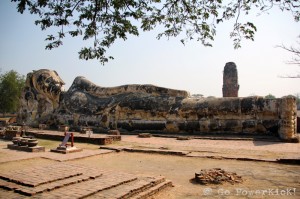 draped in a bright gold robe. Called Phra Buddhasaiyart, the Buddha stands a towering 8 meters high and 37 meter long. Made of brick and covered with plaster, the Buddha faces to the east with its head resting on a lotus blossom. In front of the statue a few vendors sell lotus flowers and incense which you can purchase if you’d like to make an offering. If you get close to the statue you can also see where devotees who have come to make merit have placed tiny squares of gold leaf on the Buddha as an offering. There is no admission charge to see the reclining Buddha and with the two smaller, but equally impressive, Buddha statues at the neighboring Wat Wora Chet Tha Ram this is a must see on your Ayutthaya temple tour.
draped in a bright gold robe. Called Phra Buddhasaiyart, the Buddha stands a towering 8 meters high and 37 meter long. Made of brick and covered with plaster, the Buddha faces to the east with its head resting on a lotus blossom. In front of the statue a few vendors sell lotus flowers and incense which you can purchase if you’d like to make an offering. If you get close to the statue you can also see where devotees who have come to make merit have placed tiny squares of gold leaf on the Buddha as an offering. There is no admission charge to see the reclining Buddha and with the two smaller, but equally impressive, Buddha statues at the neighboring Wat Wora Chet Tha Ram this is a must see on your Ayutthaya temple tour.
Wat Phra Si Sanphet
The royal temple of Wat Phra Si Sanphet stands on the grounds of the former royal palace, and its three pagodas were built to celebrate and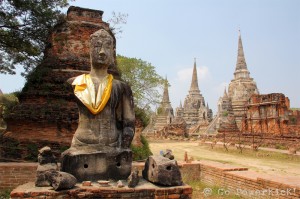 house the remains of a line of kings who ruled Ayutthaya from 1350 A.D. to 1448 A.D. Just inside the gates a model of the complex shows the once sprawling premises, which included offices for royal officials, stables to house the king’s white elephants, living quarters, gardens and the temple. The temple area was primarily used for royal ceremonies such as the swearing of allegiances and the giving of alms to monks of neighboring temples. In addition, it was also used as the private prayer area for the royal family and where their ashes were kept. Admission is 50 Baht ($1.54) and a peaceful walk around the grounds gives a sense what life might have been like inside the walls. There are some great photos ops here, especially in the evening, around 6:30pm, when the pagodas are lit up.
house the remains of a line of kings who ruled Ayutthaya from 1350 A.D. to 1448 A.D. Just inside the gates a model of the complex shows the once sprawling premises, which included offices for royal officials, stables to house the king’s white elephants, living quarters, gardens and the temple. The temple area was primarily used for royal ceremonies such as the swearing of allegiances and the giving of alms to monks of neighboring temples. In addition, it was also used as the private prayer area for the royal family and where their ashes were kept. Admission is 50 Baht ($1.54) and a peaceful walk around the grounds gives a sense what life might have been like inside the walls. There are some great photos ops here, especially in the evening, around 6:30pm, when the pagodas are lit up.
Wat Mahathat
Wat Mahathat was built in 1374 A.D. and sits in front of the grand palace at Phra Ram Park. The temple was the most sacred monastery in the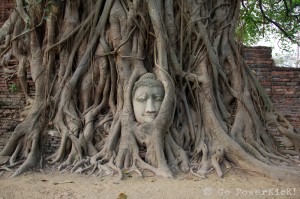 Kingdom of Ayutthaya and was also called ‘The Temple of the Great Relic.’ Helping give the temple its status and name were the revered Buddha relics housed inside its main prang as well as it being the home of the Supreme Patriarch (Sangaraja), which was the head of the Buddhist monks of the Kamavasi sect. The temple grounds were expansive and the central prang, which stood a mighty 50 meters tall, was surrounded by stupas, chedis and many different Buddha statues. During the Burmese invasion the temple was set on fire and all but a few of its statues destroyed. Today some of the original stupas and chedis still stand, defying gravity as they lean closer towards the ground. Wat Mahathat is also home to one of the most iconic images of Ayutthaya, the Buddha head resting in overgrown tree roots. No one knows exactly how this got to where it is, but one rumor is that it was too heavy for a thief looting the temple to carry over the temple walls and this is where it was dropped and has remained for hundreds of years. Admission is 50 Baht ($1.54) and I recommend coming early in the morning, around 7:15am, before the crowds arrive.
Kingdom of Ayutthaya and was also called ‘The Temple of the Great Relic.’ Helping give the temple its status and name were the revered Buddha relics housed inside its main prang as well as it being the home of the Supreme Patriarch (Sangaraja), which was the head of the Buddhist monks of the Kamavasi sect. The temple grounds were expansive and the central prang, which stood a mighty 50 meters tall, was surrounded by stupas, chedis and many different Buddha statues. During the Burmese invasion the temple was set on fire and all but a few of its statues destroyed. Today some of the original stupas and chedis still stand, defying gravity as they lean closer towards the ground. Wat Mahathat is also home to one of the most iconic images of Ayutthaya, the Buddha head resting in overgrown tree roots. No one knows exactly how this got to where it is, but one rumor is that it was too heavy for a thief looting the temple to carry over the temple walls and this is where it was dropped and has remained for hundreds of years. Admission is 50 Baht ($1.54) and I recommend coming early in the morning, around 7:15am, before the crowds arrive.
Wat Yai Chaimongkol
Standing roughly 60 meters high, the main chedi here is visible from the road when first entering Ayutthaya. The temple was initially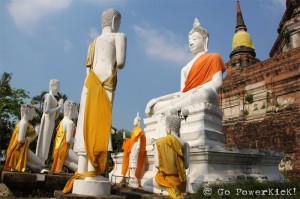 constructed in 1357 A.D for the monks of the Pa Kaeo Sect, who focused on meditation, after their return to Ayutthaya from studying under Phra Vanarat Maha Thera in Ceylon (modern day Sri Lanka). Also holding great significance in the city, the temple was the home of Somdej Phra Vanarat who was the head and Supreme Patriarch of the forest dwelling sect of monks. The large main chedi is said to have been built around 1590 A.D. by King Naaesuen the Great to commemorate his victory in an elephant back hand-to-hand duel against an invading Burmese army leader. A large reclining Buddha rests in the front of the temple and further inside is a courtyard lined on all four sides with seated Buddha images draped in orange robes. At the back of the central chedi is a scene of six Buddha statues standing, sitting, kneeling and praying beneath a larger seated Buddha. Admission is 20 Baht ($0.60) and be sure to give yourself lots of time here as it’s easy to lose track of time taking countless photos.
constructed in 1357 A.D for the monks of the Pa Kaeo Sect, who focused on meditation, after their return to Ayutthaya from studying under Phra Vanarat Maha Thera in Ceylon (modern day Sri Lanka). Also holding great significance in the city, the temple was the home of Somdej Phra Vanarat who was the head and Supreme Patriarch of the forest dwelling sect of monks. The large main chedi is said to have been built around 1590 A.D. by King Naaesuen the Great to commemorate his victory in an elephant back hand-to-hand duel against an invading Burmese army leader. A large reclining Buddha rests in the front of the temple and further inside is a courtyard lined on all four sides with seated Buddha images draped in orange robes. At the back of the central chedi is a scene of six Buddha statues standing, sitting, kneeling and praying beneath a larger seated Buddha. Admission is 20 Baht ($0.60) and be sure to give yourself lots of time here as it’s easy to lose track of time taking countless photos.
Ride an Elephant
Used in transportation, side by side humans for work and of course in battle, the elephant has been an integral part of Thai life for hundreds of 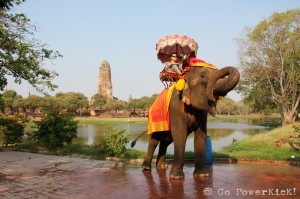 years, helping build Ayutthaya and the country into what it is today. At the north end of the city sits the Royal Elephant Kraal, a pavilion and stable where the Thai army used to round up wild elephants and train them for war. Today, the kraal provides a safe environment for over 100 elephants and also promotes the mahout (elephant trainer) culture. The kraal also has a second location in the city, adjacent to Wat Phra Si Sanphet, where elephants carry visitors through the streets allowing you the feel what this once common mode of transportation was really like. Depending on how long you want to stay atop the giant taxi, riders have the option of either a short route for 400 Baht ($12.35) or a long route for 500 Baht ($15.45).
years, helping build Ayutthaya and the country into what it is today. At the north end of the city sits the Royal Elephant Kraal, a pavilion and stable where the Thai army used to round up wild elephants and train them for war. Today, the kraal provides a safe environment for over 100 elephants and also promotes the mahout (elephant trainer) culture. The kraal also has a second location in the city, adjacent to Wat Phra Si Sanphet, where elephants carry visitors through the streets allowing you the feel what this once common mode of transportation was really like. Depending on how long you want to stay atop the giant taxi, riders have the option of either a short route for 400 Baht ($12.35) or a long route for 500 Baht ($15.45).
How To Get There
Only 86 km from Bangkok, Ayutthaya is very easy to reach with a few transportation options:
Vans
– Leaving from Victory Monument almost every hour, the cost each way is 60 Baht ($1.85) and the ride is about 1.5 hours.
Train
– Leaving in the morning from Hua Lampong station in Bangkok, the train takes roughly 2 hours.
– For the 7am train, train #111, a 3rd class seat with a fan will cost 20 Baht ($0.60) and will have you in Ayutthaya at 8:35am.
– For the express train at 8:30am, train #9, a 2nd class seat with aircon will cost 345 Baht ($10.65) and will have you in Ayutthaya at 9:42am.
See the train timetable here or Call 1690 to speak with a station representative to book tickets.
How To Get Around
Ayutthya is a relatively small city and easy to navigate. If you have the time, exploring on foot is great, however, if you are pressed for time either a bicycle, motorbike or tuk-tuk are great ways to see everything in a day.
Bicycle
– Guest houses on Naresuan Road Soi 2 rent bicycles for the day, morning until 8pm, for a cost of 40 Baht ($1.25).
Motorbike
– Some guest houses on the same Soi also rent motorbikes for the day. You will need to leave a copy of your passport or ID card as a deposit and the rental cost for the full day, until 8pm, is 200 Baht ($6.18).
Tuk-Tuk
– Tuk-tuks are everywhere is the city and depending on the driver a tour of the city could range from 800 to 1,200 Baht ($24.75 – $37.10) for the day.
– If you want a great tour of the city in a stylish Tuk-Tuk call Mr. Amnat, 089-145-0612. His tuk-tuk can hold about 6 passengers and he will take you around for a full day of temple seeing, 9 in all, for a cost of 900 Baht ($27.87).
Comments
More Good Reads!

The Best Mai Tai In The World
May 23, 2014
Helicopter Over Oahu
May 10, 2014
May 2014 PowerKicK Of The Month
May 01, 2014
Bike The Golden Gate Bridge
April 29, 2014
Hua Hin Hills Vineyard
April 19, 2014
Songkran in Nan
April 10, 2014
April 2014 PowerKicK Of The Month
April 01, 2014
Mae Hong Son Motorcycle Loop: Mae Sot to Mae Hong Son
March 28, 2014
Becoming A Buddhist Monk In Thailand
March 20, 2014






